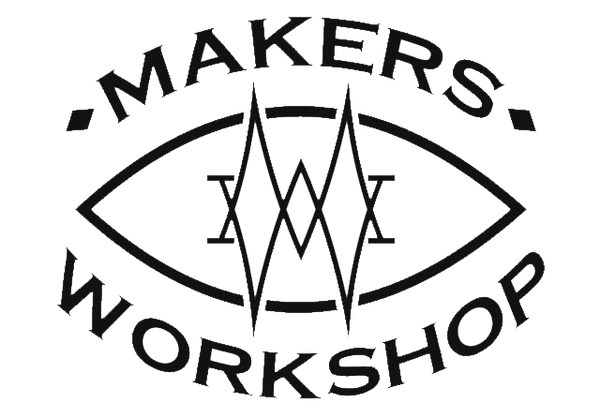Step 1
I grabbed some scrap plywood and various pieces of wood that were laying around the shop. Then I screwed them together to create one large, flat bottom panel for the mold.
Step 2
After building the bottom, I covered it with Tyvek tape so that the resin doesn’t adhere to it. I made sure to overlap each one of the pieces of tape by half an inch to minimize the risk of resin seeping out. I then repeated this process on the side panels for the mold.
Step 3
After making the side pieces, I selected some maple that we had previously cut and dried from the yard. I removed the bark using a draw knife and used the random orbital sander to get rid of any wispy pieces.
Step 4
Next, I laid my pieces out in an orientation that I liked. Then I marked the outside of the design so that I could go back and put the mold together. I covered the side pieces with Tyvek tape and screwed it all into place. Next, I went back and put additional Tyvek on the inside seams. I also sealed the corners really well to ensure that there wouldn’t be any leaks.
Step 5
Then I loaded my mold up with the wood again and used a little bit of hot glue to hold it in place and keep them from floating in the resin. Because it was just scrap wood, some of the boards were quite warped. To account for this, I took some old pieces of strapping, spaced them evenly, clamped one side down, and then screwed the other side into the side of the mold to hold the wood firmly.
Step 6
At this point, it was time to start mixing the resin. I used TotalBoat 2:1 High Performance epoxy with a medium hardener, and I colored it with Ranger alcohol inks and Diamond pigment powders. I poured the resin in multiple quarter-inch layers so that no bubbles would form. This took three or four buckets full of resin. When doing large pours like this with 2:1 it’s important to break things up into multiple smaller pours. If this is poured too thick the resin will boil as it cures.
Step 7
I let the dog dish holder sit overnight and then set to removing it from the mold. I started by taking the screws and the spacers out of the sides. Then I used the hammer and a pry bar to separate the panel from the mold. It looked great!
Step 8
I started the finishing process for the panel by using my power hand planer. Once I got it pretty much level, I switched over to the drum sander to get a nice flat surface. Then I filled in any voids with some TotalBoat 2:1 epoxy.
Step 9
After the touch-up epoxy set, I measured out my panels and cut them into smaller pieces before running them through the drum sander one last time.
Step 10
Now it was time to start the design for the CNC router using Easel Pro. I started by making an outline of a rectangle in the size that I wanted the finished dish holder to be. Then, I added two circles for the dog dishes to drop into, while the lip of the bowl could hold it in place. My final step was to add tabs. I did this by creating one long, narrow rectangle at a zero cut depth.
Step 11
Next, I put the panel into place in the CNC router and clamped it down securely before running the program. I then used a jigsaw to quickly remove the tabs and separate all the pieces. I filed the little nubs that were left from the tabs, and then I went over the whole thing with a random orbital sander to a 400 grit.
Step 12
For the dog dish holder stand, I came up with a design that used quarter-inch steel rod and some one-inch flat stock. I started by cutting all of my pieces to the right lengths. I used the angle grinder to cut the steel rods and my chop saw to cut the flat stock.
I made a couple of rectangles out of the flat stock and a couple of trapezoid shapes, because they were going to become brackets for mounting the top to the base. Then I used a hand file to neaten up the edges.
Step 13
I then marked halfway points on all the pieces from the flat stock so I could pre-drill the holes for mounting.
Step 14
Now it was time to weld it together. I started by welding the basic frame and then measuring and placing the remainder of the legs so that they were spaced equidistant and symmetrical. I then went back through and tack welded all of the flat stock to the frame for mounting to the resin.
Step 15
After verifying that the top fit on the base the way that I envisioned, I marked where the screw holes were going to be. I then drilled pilot holes using a small drill bit, being extra careful not to punch all the way through the front side of the resin.
Step 16
At this point, I wiped the entire panel down with paint thinner to remove any excess dust. Then, after letting that dry, I went back and did two coats of wipe-on polyurethane in a satin finish.
Step 17
After the poly was fully dried, I mounted the base to the panel. It looked great, but it was pretty noisy, so I added some felt to the bottom of the legs. And with that, the project was ready to go home.
The Final Result
Overall, I am really excited about how this panel technique came out! I think that this just created a stunning patterning with the contrast between the wood and the resin. Maple loved it too!
